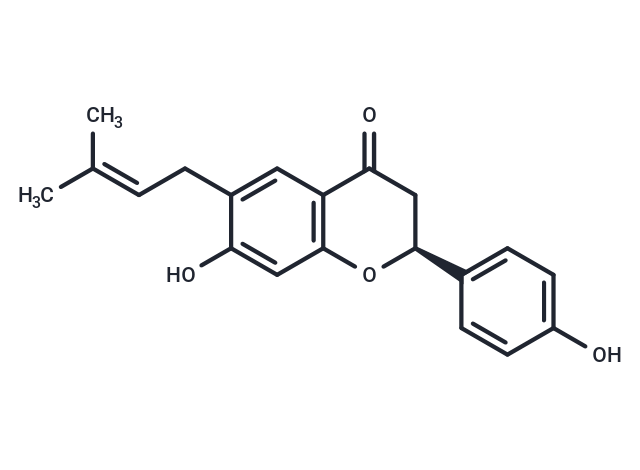Shopping Cart
- Remove All
 Your shopping cart is currently empty
Your shopping cart is currently empty

Bavachin (Corylifolin) is a phytoestrogen that activates the estrogen receptors ERα and ERβ.

| Pack Size | Price | Availability | Quantity |
|---|---|---|---|
| 5 mg | $30 | In Stock | |
| 10 mg | $37 | In Stock | |
| 25 mg | $56 | In Stock | |
| 50 mg | $78 | In Stock | |
| 100 mg | $113 | In Stock | |
| 1 mL x 10 mM (in DMSO) | $50 | In Stock |
| Description | Bavachin (Corylifolin) is a phytoestrogen that activates the estrogen receptors ERα and ERβ. |
| Targets&IC50 | ERα:320nM (EC50), ERβ:680 nM (EC50) |
| In vitro | Bavachin effectively reduces melanin production and tyrosinase (TYR) activity. At a concentration of 10 μM, it inhibits not only TYR and c-Jun N-terminal kinase (JNK) protein expression but also the expression of TYR, tyrosinase-related protein-1 (TRP-1), TRP-2, extracellular signal-regulated kinase 1 (ERK1), ERK2, and JNK2 mRNA in A375 cells. The effects of bavachin on protein and mRNA expression levels of TYR, TRP-1, TRP-2, ERK1, ERK2, and JNK2 are significantly reversed by ICI182780 and U0126. Furthermore, bavachin promotes lipid accumulation in a dose-dependent manner, evident in Oil Red O (ORO) staining experiments, and enhances preadipocyte growth at 10 μM, as demonstrated in MTT assay, compared to control cells. It also boosts bromodeoxyuridine (BrdU) incorporation into newly synthesized DNA during pre-adipocyte proliferation, a process further enhanced by insulin and by co-treatment with insulin and bavachin. Bavachin activates adipogenic factors, increases peroxisome proliferator-activated receptor gamma (PPARγ) transcriptional activity in differentiated adipocytes, and improves insulin-stimulated glucose uptake through glucose transporter type 4 (GLUT4) translocation via the Akt and AMP-activated protein kinase (AMPK) pathways. Additionally, bavachin significantly increases human monoamine oxidase-A (hMAO-A) and hMAO-B activities. It also exhibits estrogen receptor (ER) ligand-binding activity, displacing [3H] estradiol (E2) from recombinant ER, with its estrogenic activity characterized by half-maximal effective concentrations (EC50) of 320 nM for ERα and 680 nM for ERβ in a transient transfection system. Bavachin upregulates mRNA levels of estrogen-responsive genes such as pS2 and PR, while decreasing ERα protein level via the proteasomal pathway. |
| Kinase Assay | The chemiluminescent assay is used to confirm PCSEE MAO-A and MAO-B inhibitory effects and to test BNN and BVN hMAO-A and hMAO-B inhibition using MAO-Glo kit. Each enzyme's Arbitrary Light Unit (ALU) is measured in the presence of PCSEE, BNN, BVN, and standard DEP as an MAO-BI positive control. Briefly, hMAO-A and hMAO-B isozymes are diluted to 2× with reaction buffer (pH 7.4) and preincubated with 4× PCSEE, BNN, BVN, or DEP working solutions at RT for 30?min in white opaque 96-well plates. For determining activity inhibition, final 8.5?μg/mL concentrations of PCSEE, BNN, BVN, and DEP are used. For IC50 determination, 8× PCSEE and BNN working solutions are serially diluted using reaction buffers (pH 7.4) to make a 4× concentration. Ten points' range of PCSEE (1.0 to 250.0?μg/mL) and BNN (up to 400?μM (135.4?μg/mL)) final concentrations is used. Controls used are with and without ethanol. Ethanol solvent in controls is kept to a maximum final (volume) of ≤2%. Each isozyme is substituted with the reaction buffer for the blank. Based on our preliminary optimizations and Valley's method, the reaction is initiated by adding 4× luciferin derivative substrate (LDS) for a final (concentration) of 40 and 4?μM for hMAO-A and hMAO-B reactions, respectively. The final volume per well of each reaction is 50?μL. The reaction is optimized for the amount of A and B enzyme used to be incubated for less than 3.5?h at RT. To stop the reaction and produce the luminescence signal RLDR is added to all wells, 50?μL to each well, and incubated for a further 30?min. |
| Cell Research | Bavachin is dissolved in DMSO. MTT solution (20 μL) is added to each well of the 96-well plates, the cells are cultured for 4 h, the solution is discarded, and the purple crystal is dissolved in the wells with 150 μL DMSO solution, agitated in a 37°C incubator shaker for 10 min, and the optical density (OD) is measured at 490 nm by the microplate reader. |
| Alias | Corylifolin |
| Molecular Weight | 324.37 |
| Formula | C20H20O4 |
| Cas No. | 19879-32-4 |
| Smiles | CC(C)=CCc1cc2C(=O)C[C@H](Oc2cc1O)c1ccc(O)cc1 |
| Relative Density. | 1.244 |
| Storage | Powder: -20°C for 3 years | In solvent: -80°C for 1 year | Shipping with blue ice. | |||||||||||||||||||||||||||||||||||
| Solubility Information | DMSO: 58 mg/mL (178.81 mM), Sonication is recommended. Chloroform, Dichloromethane, Ethyl Acetate: Soluble | |||||||||||||||||||||||||||||||||||
Solution Preparation Table | ||||||||||||||||||||||||||||||||||||
DMSO
| ||||||||||||||||||||||||||||||||||||

Copyright © 2015-2025 TargetMol Chemicals Inc. All Rights Reserved.